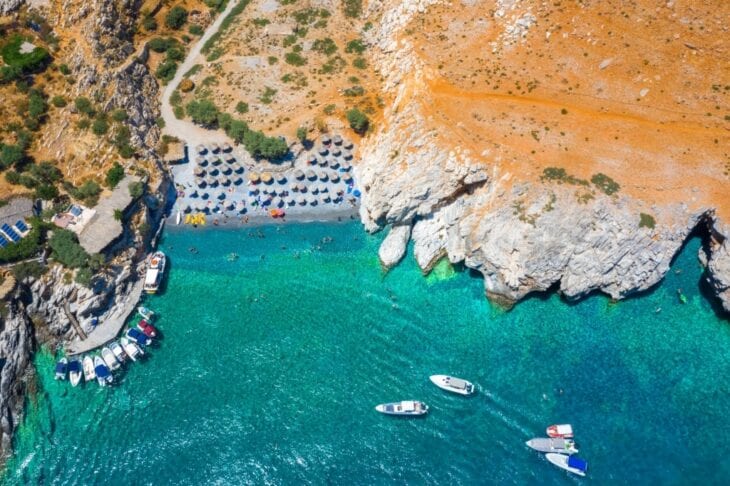Aradena Gorge: History, Hiking, Attractions and Car Rental

Aradena Gorge is situated in southwest Crete in the Sfakia region. The ancient city of Aradin or Heradin, likely founded by the Phoenicians, once stood where the now-abandoned village of Aradena is. Aradena city and village prospered during Roman, Byzantine and Venetian eras, benefiting from trade and shipping activities. Landmarks in Aradena like the 14th-century Church of the Archangel Michael in the village showcase the area’s historical significance. Aradena faced destruction several times: post the Daskalogiannis-led rebellion against Ottomans in 1770, during the Greek War of Independence in 1821 and amidst the 1867 conflict with Turkish and Egyptian armies. Aradena village was deserted after a family feud in 1948 left multiple dead. In 1986, the Vardinogiannis family financed a 138-meter-high steel bridge over the gorge, facilitating access and boosting tourism with activities like bungee jumping. Aradena is slowly reviving, with descendants returning and refurbishing homes. Aradena Gorge Trai trail spanning 2.5 km and takes approximately 2-3 hours to hike.
Aradena Gorge to Marmara Beach is a 6.1 km route leading to the Libyan Sea’s Marmara Beach and it takes around 3-4 hours. Aradena to Loutro hiking trail is a more extensive 10 km trail that ends at the village of Loutro and usually takes 3-4 hours. Aradena to Anopolis hike is 2.4 km long and leads to the mountain village of Anopolis. This trail takes roughly 1 hour. Aradena Gorge Loop is a comprehensive hike combining various paths, measuring around 12.9 km requires 6-8 hours to finish.
Hiking the Aradena Gorge does not require a guide but can be beneficial for novices or longer routes. Best time to visit is spring (April-June) and autumn (September-November). The nearest attractions to Aradena Gorge include the Samaria Gorge, Marmara Beach, Loutro, Agios Pavlos Beach, Agia Roumeli Beach, Sfakia and Filaki Beach. Renting a car is possible to reach Aradena Gorge. When renting, factors to consider include insurance, driver’s age, car type and required documentation. Crete car rental cost varies based on duration and car type, but a general estimate is around €250 for a week or €30 to €40 per day.
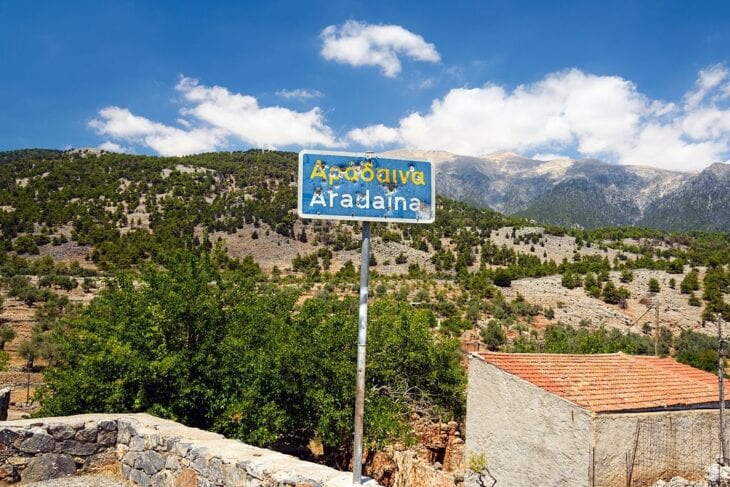
What is the history of Aradena Gorge?
Aradena Gorge has a rich and varied history, marked by periods of prosperity as well as hardship. The gorge is located in the Sfakia region of southwest Crete. The abandoned village of Aradena sits at the edge of the gorge. Ruins found in the area indicate that Aradena was the site of the ancient city of Aradin or Heradin, which was likely founded by the Phoenicians. The city thrived during Roman, Byzantine and Venetian rule. During these periods, Aradena prospered thanks to trade and shipping, with inhabitants docking their ships in the nearby coastal village of Loutro. The 14th century Church of the Archangel Michael in the village contains rare frescoes dating to this time.
However, the village and gorge also suffered repeated destruction. Aradena was razed after the failed rebellion against the Ottomans led by Daskalogiannis in 1770. It faced further ruin during the 1821 Greek War of Independence and later in 1867 during conflicts between Cretan rebels and the occupying Turkish and Egyptian armies. The village persisted but began emptying out in the years following World War II due to the remoteness and harsh living conditions. The final blow came after a bloody feud erupted between two families in 1948 over a trivial incident, resulting in multiple deaths. The remaining villagers fled, leaving Aradena deserted.
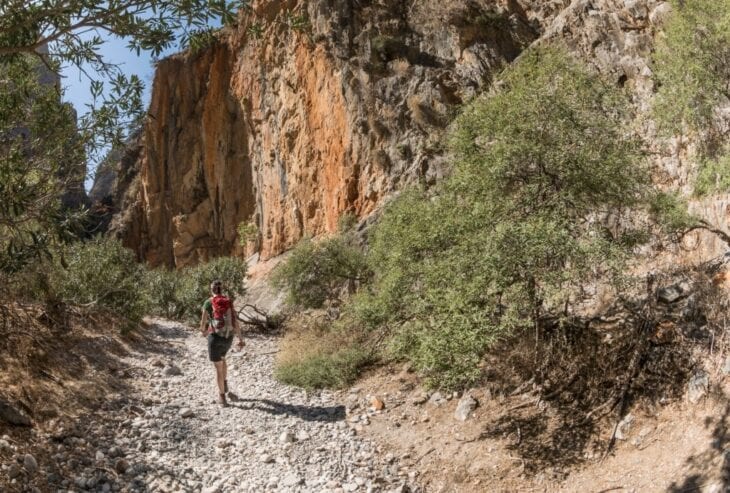
The abandoned village then sat untouched for decades, with the gorge accessible only by hiking trails. This changed in 1986 when the prominent Vardinogiannis family funded the construction of a steel bridge spanning the gorge near Aradena. At 138 meters high, this Bailey bridge connected the village by road to the nearby town of Anopoli. The bridge also enabled the rise of bungee jumping in the gorge, with jumps held regularly during summer months. While drawing adventurous tourists, the bridge also led to the slow revival of Aradena village. Descendants of former residents have begun returning and renovating houses. The village still retains its ghostly, abandoned feel but now shows signs of reemerging as a remote outpost that is both scenic and historic. Aradena Gorge and village thus remain a poignant vestige of Crete’s storied past, gradually welcoming new life while still bearing the traces of prior centuries.
What is the archaeology of Aradena Gorge?
The Aradena Gorge is located in the Sfakia region of southwestern Crete, extending inland from the Libyan Sea. Archaeological evidence indicates the gorge has been inhabited since ancient times, beginning in the Minoan period around 3000-2800 BC. Remains of the ancient city of Aradin, also known as Heradin or Iradin, have been found at the site of Passopetra near the modern village of Aradena. Aradin was likely founded by Phoenicians. It was an autonomous city that minted its own coins and thrived from the end of the Venetian era until 1770. Excavations have uncovered tombs, ruins of dwellings and fortification walls dating to the Archaic, Classical, Hellenistic, Roman and Byzantine periods.
Of particular archaeological significance is the 14th century church of the Archangel Michael, built atop the ruins of a 5th-6th century early Christian basilica that was the seat of a bishopric. The surviving church contains 14th century frescoes and other decorations. Nearby, the remains of an ancient cemetery have been found. Together, the ecclesiastical ruins and cemetery reflect the continuous inhabitation and prosperity of Aradin from antiquity through medieval times.
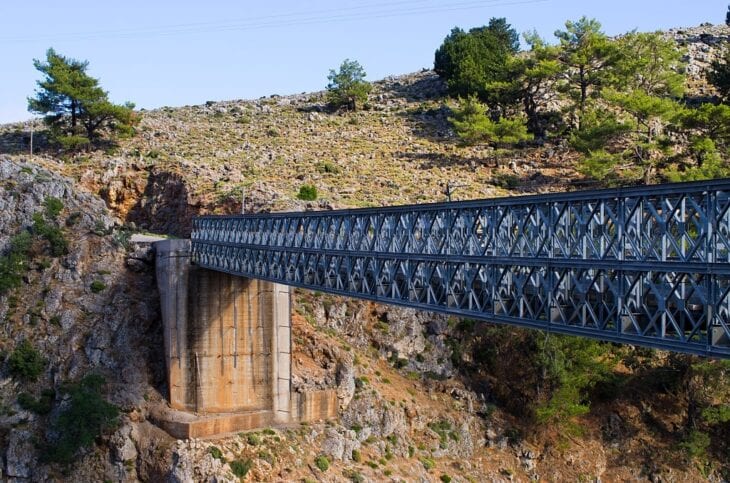
The archaeology of the Aradena Gorge reveals it was home to an important city in ancient times that maintained regional authority and economic vitality for centuries. While the specific layout and extent of the ancient city is still being uncovered, existing ruins and artifacts provide valuable insight into its civic administration, religious practices, commerce, daily life and defense over time. The continuity of occupation extending into the modern village of Aradena is an indicator of the gorge’s persistent geopolitical and strategic significance throughout Cretan history. Future archaeological excavations will likely expand knowledge of the ancient city’s material culture and relationship to the wider region. For now, the gorge presents archaeologists with the remains of a major ancient Cretan center that was influential in regional affairs for over a millennium.
How was Aradena Gorge formed?
Aradena Gorge, like many other gorges in Crete, was formed through a process of geological erosion over millions of years. The specific geological history of Aradena Gorge can be attributed to the combination of tectonic forces and the erosive power of water. Listed below are the possible processes of how aradena gorge was formed.
- Tectonic Activity: The geological formation of Aradena Gorge began with tectonic processes. Crete, the island where Aradena Gorge is located, is situated at the convergence of the African and Eurasian tectonic plates. The movement of these plates, particularly the African plate subducting beneath the Eurasian plate, led to the uplift of the island and the formation of mountain ranges, including the White Mountains (Lefka Ori), where Aradena Gorge is found.
- River Erosion: Over time, as the mountains rose, rivers and streams started to carve their way through the landscape. In the case of Aradena Gorge, the Aradena River, also known as the Chalasea River, played a significant role. The river’s persistent flow gradually eroded the soft limestone rocks, cutting deeper and deeper into the landscape.
- Karst Processes: The geology of the region is characterised by limestone formations. Limestone is a soluble rock that can be easily weathered and dissolved by acidic water. As the Aradena River flowed through the region, it interacted with the limestone, slowly dissolving and widening the gorge through chemical erosion. This process, known as karstification, contributed to the formation of the steep cliffs and narrow passages that characterise the gorge.
- Geological Time Scale: The formation of Aradena Gorge is a slow and ongoing process, spanning millions of years. The erosive power of the river and the geological changes caused by tectonic activity have shaped the gorge into its current form.
Today, Aradena Gorge stands as a stunning gorge to the forces of nature, displaying the impressive results of geological processes at work over vast periods of time. Its breathtaking beauty and unique terrain make it a popular destination for hikers, nature enthusiasts and anyone seeking to witness the marvels of the Earth’s geological history.
How is the Aradena Gorge preserved?
Aradena Gorge is actively preserved to protect its natural beauty, geological features and cultural heritage. The local authorities, together with conservation organisations, have implemented measures to ensure sustainable tourism and environmental protection.
Preservation efforts focus on maintaining the hiking trails and ensuring the safety of visitors while minimising the impact on the delicate ecosystem. Signage and informational boards are placed strategically to educate hikers about the gorge’s importance and the need to respect its natural environment.
Furthermore, strict regulations are in place to safeguard any archaeological findings or historical sites within the gorge. Excavations and research are conducted under controlled conditions to preserve the integrity of any discovered artefacts or structures. These include restrictions on construction and development, controlled tourism and establishing hiking paths to prevent unregulated exploration. Additionally, educational programs and awareness campaigns are conducted to inform visitors about the fragile nature of the ecosystem and the importance of responsible tourism. Regular monitoring and assessment of the environmental conditions are carried out to identify any threats to the area and take appropriate action.
Local communities also play an essential role in the preservation efforts, as they often act as custodians of their natural heritage, passing down traditional knowledge and sustainable practices to future generations. The combined efforts of responsible tourism, conservation initiatives and community involvement contribute to preserving Aradena Gorge for future generations to experience and appreciate its historical, ecological and cultural significance.
By promoting responsible tourism and respecting the delicate balance of the ecosystem, Aradena Gorge can continue to be appreciated by visitors while safeguarding its unique natural and cultural heritage for future generations.
How does the Aradena Gorge map look?
The Aradena Gorge map presents fascinating trails and paths. Starting from the deserted village of Aradena, the route follows the gorge’s narrow path, winding through rocky terrain, spectacular cliffs and verdant vegetation.
The trail descends steeply into the gorge, crossing the ancient iron bridge and then snakes its way along the dry river bed. The trail emerges at the picturesque Marmara beach on the Libyan Sea, presenting a splendid finale to the walk. Side trails lead to hidden archaeological gems, secluded viewpoints and areas of exceptional biodiversity, further enhancing the gorge’s allure. The map also highlights the location of local amenities, including resting spots, picnic areas and first aid stations.
Below is an image of the map of the Aradena Gorge.
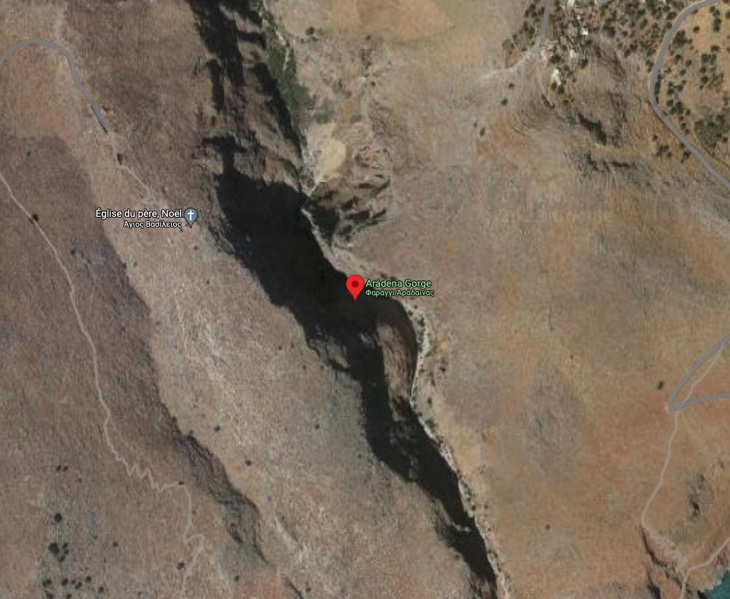
What are the hiking routes for Aradena Gorge?
Listed below are hiking routes in Aradena Gorge:
- Aradena Gorge Trail: The Aradena Gorge Trail is the main and most popular route through the gorge. It starts from the abandoned village of Aradena and follows the course of the Aradena River. The trail takes you through narrow passages, alongside towering cliffs and offers breathtaking views of the rugged landscape. The hike can be challenging, with some rocky and uneven terrain, but it is well-marked and suitable for experienced hikers. The main Aradena Gorge Trail is 2.5 km (1.5 miles) in length.The duration of hiking the Aradena Gorge Trail can vary depending on several factors, including the hiker’s pace, fitness level and the number of stops taken to admire the scenery or rest. On average, it typically takes around 2 to 3 hours to complete the Aradena Gorge Trail.
- Aradena to Marmara Beach: This route takes you from the village of Aradena to the beautiful Marmara Beach located on the Libyan Sea. The hike begins in the gorge and leads you down towards the coast. The trail offers diverse landscapes, from the dramatic gorge to the coastal scenery. The descent to Marmara Beach can be steep in places, so proper footwear and caution are advised.The distance between Aradena and Marmara Beach is 6.1 km (3.82 miles), making it a relatively short but rewarding hike. On average, this hiking route can take around 3 to 4 hours to complete.
- Aradena to Loutro: The trail from Aradena to Loutro is a great option for those seeking a longer and more adventurous hike. This route combines the Aradena Gorge hike with a coastal path leading to the charming village of Loutro. The hike takes you through stunning coastal landscapes and offers breathtaking views of the sea. It’s a more challenging hike, covering a longer distance and may require an overnight stay in Loutro. The distance between Aradena and Loutro is 10 km (6.4 miles). On average, this hiking route can take approximately 3 to 4 hours to complete.
- Aradena to Anopolis: The Aradena to Anopolis trail leads you from the village of Aradena to the traditional village of Anopolis, situated high in the mountains. The hike offers a mix of gorge and mountain landscapes, allowing you to experience the diversity of the region’s terrain. Anopolis is a picturesque village with narrow streets and a glimpse into the local way of life. The distance between Aradena and Anopolis is approximately 2.4 km (1.5 miles). The time it would take to hike from Aradena to Anopolis can vary depending on individual hiking pace, fitness level and stops made along the way. On average, this hiking route can take around 1 hour to complete.
- Aradena Gorge Loop: For a more extended adventure, some hikers opt to do a loop that combines different routes, including parts of the Aradena Gorge Trail, the path to Marmara Beach and the coastal trail to Loutro or other neighbouring villages. This loop offers a comprehensive experience of the gorge and its surroundings. The total distance covered in the Aradena Gorge Loop can be around 12.9 km (8 miles), depending on the specific route taken and any detours or side trails explored along the way. And, on average it would take one 6 to 8 hours to complete the Aradena Gorge Loop.
Before walking any hike in Aradena Gorge, it is essential for one to be prepared with proper hiking gear, sufficient water and snacks. Some parts of the trails can be challenging, so it’s advisable to have some hiking experience or go with a guided group if you are less experienced. Additionally, one should always check the weather forecast and trail conditions before setting out, as conditions in the gorge can change rapidly.
How long is the hike to Aradena Gorge?
The hike through Aradena Gorge offers varying durations depending on the chosen route and individual hiker’s pace. The main Aradena Gorge Trail, covering a distance of 2.5 km (1.5 miles), typically takes 2 to 3 hours to complete. This duration accounts for differences in fitness levels and any stops taken to admire the breathtaking scenery along the way. For more extensive excursions that encompass coastal paths or mountain villages, the hike can extend to a full day or more, covering greater distances and elevations. It is essential to be prepared for the chosen route’s specific challenges and to consider personal endurance levels when planning the hike.
Do you need a guide to hike the Aradena Gorge?
No, a guide is not required to hike the Aradena Gorge. For experienced hikers and those familiar with the area, a guide may not be necessary for the main Aradena Gorge Trail. The path is relatively well-marked and many hikers tackle it independently. However, for longer or more challenging routes or for those less experienced, hiring a local guide can enhance the experience, provide valuable insights and ensure safety.
What are the risks in hiking in Aradena Gorge?
There are no specific restrictions imposed on hiking Aradena Gorge. However, it’s important to note that natural areas like gorges can be subject to unpredictable conditions and may not be suitable for everyone. Hikers should respect any signage, follow designated trails and adhere to safety guidelines provided by local authorities or experienced hikers.
Hiking Aradena Gorge can present various difficulties that hikers should be aware of before embarking on their journey. Listed below are the challenges while hiking in Aradena Gorge:
- Uneven Terrain: The terrain within the gorge can be rugged and uneven, with rocky surfaces and loose stones. Hikers should be prepared for challenging footing, which may require proper hiking shoes with good traction.
- Steep Descents and Ascents: Depending on the chosen route, hikers may encounter steep descents or ascents, especially when accessing the gorge from the surrounding villages. These sections can be physically demanding and may require a moderate to high level of fitness.
- Narrow Passages: Some parts of the gorge trail may feature narrow passages and tight spaces, which can be intimidating for those with claustrophobia or fear of heights.
To mitigate risks and ensure a safe and enjoyable hiking experience, hikers should prepare adequately, be in good physical condition and be cautious while exploring the wonders of Aradena Gorge. Additionally, seeking advice from experienced hikers or local guides can be beneficial for navigating the challenges and maximising safety during the hike.
When is the best time to visit Aradena Gorge?
The best time to visit Aradena Gorge is during the spring (April to June) and autumn (September to November) months. During these periods, the weather is generally pleasant and the landscape is adorned with colourful flora. Summer (July to August) can be hot and less comfortable for hiking, while winters (December to February) may bring colder temperatures and potential rainfall.
What are the things to bring when visiting Aradena Gorge?
When visiting Aradena Gorge for a hike, it is essential to be well-prepared with the right equipment and supplies to ensure a safe and enjoyable experience. Listed below is the things to bring when visiting Aradena Gorge:
- Hiking Shoes: Sturdy and comfortable hiking shoes with good traction are crucial for navigating the uneven and rocky terrain of the gorge.
- Water: An ample supply of water to stay hydrated, especially during hot weather and long hikes is important.
- Snacks: Energy-rich snacks like granola bars, nuts or dried fruits help keep energy levels up during the hike.
- Sun Protection: One should wear a hat, sunglasses and sunscreen to protect themselves from the strong Cretan sun.
- Weather-Appropriate Clothing: One should dress in layers and choose moisture-wicking clothing suitable for the weather conditions. Visitors should keep in mind that temperatures can change in the gorge, so being prepared for varying conditions is essential.
- First Aid Kit: A basic first aid kit with essentials like adhesive bandages, antiseptic wipes, pain relievers and any personal medications is important.
- Map and Compass/GPS: A map of the area and a compass or GPS device is important to help navigate the trails and avoid getting lost.
- Mobile Phone: Hikers should carry a fully charged mobile phone for emergency purposes. They should keep in mind that network coverage may be limited in remote areas.
- Headlamp or Flashlight: If one plans to hike during the early morning or late afternoon, having a headlamp or flashlight can be useful.
- Backpack: One should use a comfortable and appropriately-sized backpack to carry all essentials.
- Camera: Visitors shouldn’t forget to bring a camera or smartphone to capture the stunning scenery of the gorge.
- Cash: One should bring some cash with them, as there may be opportunities to buy snacks, drinks or souvenirs in nearby villages.
- Insect Repellent: Depending on the season and location, there may be insects in the area. Visitors should carry insect repellent to protect them from bites.
Remember that Aradena Gorge is a natural wilderness area and it’s essential to leave no trace of your visit. Respect the environment, follow designated trails and take all your trash back with you. Additionally, if one plans to embark on more extended or challenging hikes, consider hiring a local guide for added safety and guidance.
What are the nearby attractions in Aradena Gorge?
Liste below is the the nearby attractions in Aradena Gorge:
- Samaria Gorge: Samaria Gorge is located in Southwest Crete within the regional unit of Chania. The Samaria Gorge boasts a rich diversity of over 450 species of plants and animals, earning it the prestigious title of a World Biosphere Reserve. The gorge 16 km (9.94 miles) long and 150 m (492.13 feet) wide.
- Marmara Beach: Marmara Beach is located on the Libyan Sea, Marmara Beach is a secluded and picturesque spot accessible via the Aradena to Marmara Beach hiking route. Marmara Beach is situated on the southern coast of Crete, Greece, with the nearest town being Loutro, located approximately 3 to 4 km (1.86 to 2.48 miles) away. The beach is approximately 167 km (103.77 miles) from the island’s capital, Heraklion and about 94 km (58.41 miles) from Chania. Nearby, visitors can find popular coastal cities like Paleochora, Chora Sfakion and Sougia. For precise navigation, the GPS coordinates for Marmara Beach are 35.1966° N, 24.0582° E.Its crystal-clear waters and stunning coastal scenery make it an ideal place for relaxation and swimming.

- Loutro: Loutro, a small and remote seaside village in southern Crete, is located approximately 96 km from Chania. The main town of Chania is about a 2-hours drive away from Loutro. It is also accessible via the Aradena to Loutro coastal hiking route. Loutro is a captivating fishing village with traditional white-washed houses.
- Agios Pavlos Beach: Agios Pavlos Beach is a serene and less-visited beach with golden sands and clear waters situated on the southern coast of Crete. The unique rock formations add to the beauty of this tranquil spot. The distance to Agios Pavlos Beach from Aradena Gorge is approximately 71.9 km (44.6 miles).
- Agia Roumeli Beach: Agia Roumeli boasts a pebble beach and the refreshing waters of the Libyan Sea is nestled near the exit of Samaria Gorge. It is a popular stop for hikers completing the Samaria Gorge trek. The distance from Aradena Gorge to Agia Roumeli Beach is approximately 22.2 km (13.17 miles) and includes using a ferry.
- Sfakia: Sfakia is one of Crete’s most authentic and historically rich regions. It offers a glimpse into traditional Cretan culture and hospitality. The charming village features narrow streets, a small port and a friendly ambiance. The distance from Aradena Gorge to Sfakia is approximately 12.9 km (8 miles).
- Filaki Beach: Filaki Beach is a remote and unspoiled sandy beach with clear waters and stunning surroundings located west of Sfakia. It is a quiet spot ideal for those seeking tranquillity and seclusion. The distance from Aradena Gorge to Filaki Beach is approximately 15.7 kms (9.8 miles).
What is the contribution of Aradena Gorge in the tourism of Crete?
The contribution of Aradena Gorge to the tourism of Crete is significant, as it attracts a considerable number of visitors seeking unique outdoor experiences and the opportunity to explore the island’s natural wonders. The gorge’s rugged beauty, stunning landscapes and challenging hiking trails make it an appealing destination for adventure seekers and nature enthusiasts.
- Hiking Tourism: Aradena Gorge offers an exciting hiking experience, with various routes that cater to different levels of difficulty and interests. Hikers from around the world are drawn to the challenge of navigating the gorge’s rocky terrain and revelling in the breathtaking scenery along the way. The popularity of hiking in Aradena Gorge contributes to the tourism industry by attracting both domestic and international visitors, boosting local economies through accommodation bookings, restaurant visits and related services.
- Adventure Tourism: The gorge’s impressive cliffs and steep terrain have also made it a hotspot for adventure tourism. Extreme sports enthusiasts, like base jumpers, are drawn to the towering cliffs, providing niche tourism opportunities for adrenaline-seekers. This form of adventure tourism diversifies Crete’s offerings, attracting a specific audience looking for unique and thrilling experiences.
- Cultural and Ecotourism: Aradena Gorge is surrounded by traditional Cretan villages and exhibits a unique cultural heritage. As hikers explore the gorge and its nearby attractions, they have the chance to experience the local lifestyle, sample traditional Cretan cuisine and immerse themselves in the island’s rich history. This blend of cultural and ecotourism enhances the overall appeal of the region and encourages sustainable tourism practices that benefit local communities.
- Promotion of Lesser-Known Areas: Aradena Gorge’s popularity has also led to increased attention on lesser-known regions of Crete. While the island has several well-known tourist destinations, the attraction of Aradena Gorge and the surrounding areas has encouraged visitors to explore off-the-beaten-path locations. This disperses tourism across the island, reducing the strain on popular tourist hotspots and promoting a more balanced distribution of visitors.
- Nature Conservation: The interest in Aradena Gorge has highlighted the importance of preserving the island’s natural landscapes. Conservation efforts and responsible tourism practices are often emphasised to protect the gorge’s fragile ecosystem and maintain its allure for future generations.
Aradena Gorge plays a vital role in the tourism of Crete by drawing visitors with its exceptional hiking experiences, adventure opportunities, cultural encounters and focus on sustainable tourism. Its contribution to the tourism industry extends beyond just attracting visitors to the gorge itself, as it also promotes the exploration of lesser-known regions, supporting local economies and fostering an appreciation for the island’s natural beauty and cultural heritage.
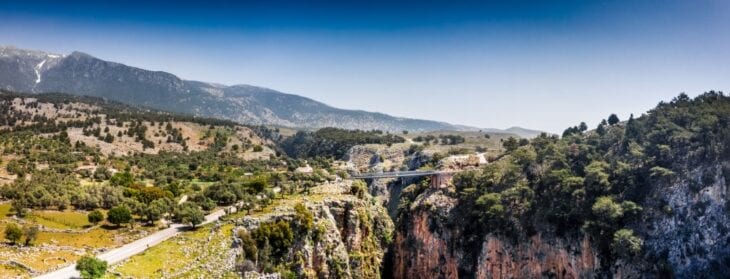
Can you rent a car going to Aradena Gorge?
Yes, you can rent a car to go to Aradena Gorge in Crete. Renting a car is a popular option for travellers who want to have more flexibility and convenience in exploring the island’s attractions, including remote locations like Aradena Gorge. However, it’s important to note that some parts of the route to Aradena Gorge may involve narrow and winding roads. Visitors should exercise caution while driving and be aware of local traffic rules and regulations. Additionally, it’s advisable to check the condition of the roads and weather forecasts before embarking on the trip, especially during adverse weather conditions or winter months when some areas might be affected by heavy rain or snow.
What are the factors to consider before renting a car in Crete?
Car rental is a popular and essential mode of transportation for tourists travelling around Crete, as it offers private and flexible mobility to reach various destinations. To choose the right car rental in Crete, consider the following factors:
- Insurance: Ensure that the rental car comes with comprehensive insurance coverage to protect against potential accidents or damages during your trip.
- Driver’s Age: Most car rental companies require drivers to be at least 21 years old and to have held a valid driving licence for a minimum of 12 months. Confirm that you meet the age and licence requirements before renting a car.
- Car Type: One must learn how to choose the right car to rent in Crete.Choose a car that suits your specific needs. Car types vary in size and capacity, accommodating different numbers of passengers and luggage. Select a car that comfortably accommodates your travel group.
- Documents Needed: In addition to a valid driving licence, you’ll need a credit or debit card in the name of the main driver to provide the car rental company with a security guarantee.
- Driver’s Gender: In Crete and Greece, there are no gender-based restrictions for driving and both male and female drivers can operate rental cars without any limitations.
Renting a car in Crete offers the advantage of privacy and flexibility, particularly during the pandemic, where private transportation can provide added safety and peace of mind. With numerous car rental companies available, tourists have plenty of options to choose from based on their preferences and requirements. By considering these factors before renting a car, tourists can ensure a smooth and enjoyable experience while exploring the beautiful island of Crete.
How much does a car rental in Crete cost?
The cost of a car rental in Crete depends on the rental duration, the number of passengers and the type of car selected. For a week-long rental, the approximate cost can be around €250, which typically includes unlimited mileage and a four-seater car with manual transmission, air conditioning and four doors. For day trips and night trips the Crete car rental cost is about €30 to €40, following a 24-hour rental period. The rental cars are equipped with manual transmission, air conditioning and have four doors. It’s important to return the rented car to the company with the same amount of fuel as at the start of the trip to avoid any additional charges.
Does renting a car provide you with the leisure you seek when travelling?
Yes, renting a car can provide you with the leisure you seek when travelling. Renting a car offers several benefits that enhance the leisure and convenience of your travel experience. With a rented car at your disposal, you have the flexibility to create your own itinerary and explore various attractions at your own pace. You are not bound by fixed schedules or dependent on public transportation, giving you the freedom to visit off-the-beaten-path destinations and spend as much time as you want at each location.
What visitors say about Aradena Gorge?
Aradena Gorge is considered one of the most beautiful gorges on Crete, according to visitors. Many reviewers describe it as an impressive, breathtaking natural spectacle. The hike from the bridge down to Marmara beach is around 7 km long and described as moderately difficult, suitable for fit hikers. There are some sections requiring climbing and scrambling using ropes that have been installed. Aradena gorge has far less visitors than the popular Samaria gorge, adding to its appeal. The lack of crowds and tourist facilities give it a remote, adventurous feel. The final stretch opens up to the beautiful Marmara beach, with crystal clear waters perfect for swimming and small caves to explore.Visitors recommend wearing proper hiking shoes, bringing plenty of water, and starting early to avoid the midday heat. Aradena gorge hike typically takes 3-5 hours. Most visitors feel the challenging hike is worth the reward of the beach. Many get a taxi or boat back to their starting point rather than hiking back up. Overall, reviews describe it as an impressive, quiet hike with stunning coastal views and a beautiful destination beach.
What are the nearest traveller’s inns to Aradena Gorge?
Listed below are the nearest accommodation options to Aradena Gorge:
- Apartments Madari Anopoli: Apartments Madari is a family-run apartment complex located uphill from the beach in Anopoli village. Offering simple studio apartments from €40-60 per night, these budget apartments sleep up to 3 people with basic kitchenettes and private bathrooms. There is a shared pool and BBQ area. Reviews mention the clean rooms, tranquil village location and warm hospitality of the owners.
- Alonia Guesthouse: Alonia Guesthouse is a cosy 8-room inn in the mountain village of Aradena. With doubles starting at €50 per night including breakfast, it has rustic-chic rooms with en-suite bathrooms and balcony views. Amenities include a communal lounge, garden terrace and honesty bar. Guests compliment the friendly service, delicious breakfasts and quiet village charm.
- Hotel Alkyon: Hotel Alkyon is a family-run seaside hotel in Chora Sfakion town. It offers doubles with en-suite bathrooms from €60 per night including breakfast. Located right on the waterfront promenade, amenities include a restaurant, pool bar, sun terrace and beachfront access. Reviews consistently praise the location, cleanliness, hospitality and amazing views of the harbour.
Where to eat and drink near Aradena Gorge?
Listed below is are the best places to eat and drink near Aradena Gorge:
- Dialeskari Tavern: Dialeskari Tavern is a family-run Greek restaurant located in the seaside village of Loutro in southwest Crete. Perched right on the waterfront overlooking the picturesque harbour, this tavern serves delicious traditional Cretan cuisine made from locally-sourced ingredients. Reviews praise the friendly service, generous portions and fair prices. Popular dishes include oven-baked lamb, rabbit stew, stuffed vegetables and fresh grilled fish. With its idyllic setting at the water’s edge, Dialeskari Tavern offers an authentic taste of Crete accompanied by beautiful sea views.Taverna Dialeskari is a charming restaurant located in Sfakia, Crete, known for its spectacular views overlooking the beautiful Marmara Bay. Accessible only by boat or foot, this taverna offers a delightful dining experience in a picturesque setting. Travellers have praised the attentive and friendly service provided by the staff, making it a pleasant place to dine. The menu features a selection of traditional Greek taverna food, including salads and well-prepared lamb dishes. Visitors have particularly recommended trying their Staka, Ancient Salad, Siglina and Lamb in Wood Oven. The house wine is also highly regarded at an affordable price. Overall, Taverna Dialeskari receives positive reviews for its fantastic location, great food and excellent service.
- The Small Paradise Nikos Restaurant: The Small Paradise Nikos Restaurant is a charming family-owned restaurant situated uphill from the idyllic Marmara Beach in southwest Crete. Set amidst olive groves with panoramic views over the Libyan Sea, this secluded open-air eatery serves up delightful Greek and Cretan dishes. Reviews rave about the warm hospitality, delicious food and romantically tranquil ambiance. Signature offerings include moussaka, stuffed tomatoes, homemade pies, Greek salads and fresh grilled fish. Perched on a hillside with sublime sea vistas, The Small Paradise Nikos Restaurant is a hidden gem offering a taste of genuine Cretan cuisine and hospitality.
- Platanos Tavern and Rooms: Platanos Tavern and Rooms is a cosy family-run lodging and restaurant located in the scenic mountain village of Aradena in southwest Crete. It offers simple but comfortable rooms along with a rustic tavern serving home-cooked Cretan specialties. Reviews praise the friendly service, delicious food and good value. The tavern menu focuses on classic Greek fare like moussaka, meatballs, stuffed vegetables, Greek salads, with a few local specialties. Set beneath shady platanos trees near the entrance to Aradena Gorge, this family-run oasis charms guests with its warm hospitality and serene village setting.
Is it possible to hire a hiking guide in Aradena Gorge?
Yes, it is possible to hire a hiking guide in Aradena Gorge. For visitors who prefer a guided hiking experience or want to ensure safety and knowledge about the area, hiring a hiking guide is a viable option. There are local guides and tour operators in the region who offer guided hiking tours through Aradena Gorge. These guides are experienced and knowledgeable about the trails, terrain and points of interest within the gorge.
What kind of car should you rent when visiting Aradena Gorge?
An SUV and particularly the Peugeot 5008 Auto is an ideal car for renting when visiting Aradena Gorge. It is recommended to rent a sturdy and reliable car that can handle the rugged terrain and winding roads in the region. Opting for an SUV or a mid-sized 4×4 vehicle can be a suitable choice. These types of cars offer better ground clearance and traction, making them more capable of navigating the uneven and rocky surfaces in and around the gorge. The Peugeot 5008 is a 5-passenger car.
Car rental agencies, like Rental Center Crete, typically offer a variety of car models to choose from. When selecting a car, consider factors such as the weight capacity and passenger capacity. Ensure that the car can comfortably accommodate all the passengers and their belongings, especially if you plan to explore other attractions in the region.
Having a car with sufficient passenger capacity allows for a more comfortable and enjoyable journey, as everyone can travel together. Additionally, the extra space for luggage and hiking gear ensures a hassle-free experience during your visit to Aradena Gorge.
Before finalising one’s car rental, confirm that the car is in good condition, well-maintained and equipped with air conditioning, especially during the hot summer months in Crete. This will provide a comfortable and enjoyable driving experience as one explores the stunning landscapes and natural beauty of Aradena Gorge and its surroundings.
Can elderly people hike the Aradena Gorge?
Yes, elderly people can hike Aradena Gorge, but it can be challenging due to the rugged terrain and uneven surfaces. Those in good health and with moderate fitness levels might be able to hike certain portions of the gorge. However, precautions should be taken and individuals with significant health concerns or mobility issues should consider enjoying the views from viewpoints or nearby accessible areas.
Can a couple hike the Aradena Gorge?
Yes, a couple can hike Aradena Gorge together. It can be an adventurous experience for couples who enjoy outdoor activities and exploring nature. The stunning landscapes provide a thrilling backdrop for a memorable hike together, creating lasting memories and bonding opportunities.
Is hiking Aradena Gorge child-friendly?
No, hiking Aradena Gorge is not child-friendly for young children, especially those of very young ages or with limited hiking experience. The challenging terrain and potential safety risks make it unsuitable for young children. Families with older children who are experienced hikers and can manage the terrain may find certain sections more child-friendly, but parents should still exercise caution and assess their children’s capabilities.
Last updated on February 11th, 2025








